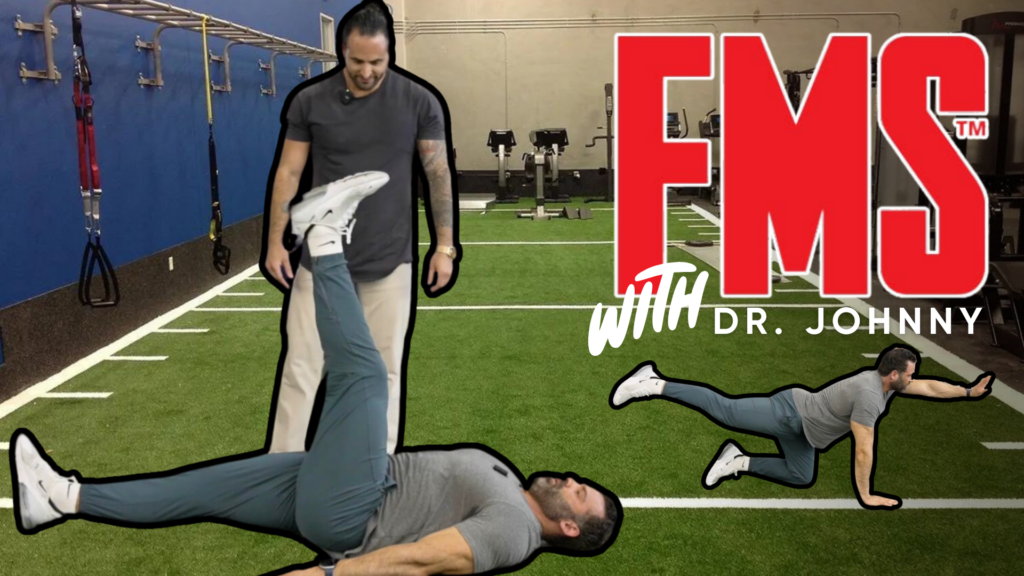Today, we’re diving into something that’s incredibly helpful for anyone training at any level: a Functional Movement Screen, or FMS. If you’ve never done one before, an FMS is a phenomenal way to test for any mobility limitations or imbalances that might lead to injury or hinder your performance in the gym.
So what happens if you don’t have access to the official FMS equipment or a certified coach? No worries — I’ve got you covered with an abbreviated, at-home version that’ll still give you powerful insights into how your body moves.
I’m walking through this demo with Dr. Johnny, a sports chiropractor and the owner of Warrior NYC, a movement-focused physical therapy and chiropractic clinic based in Manhattan. He specializes in injury rehab, sports therapy, and getting people back to training hard, pain-free.
Let’s get into it — here are the 7 foundational FMS movements and how to perform them at home.
1. Deep Squat
What it tests: Overall mobility (especially ankles, hips, and thoracic spine)
How to do it:
- Stand with your feet shoulder-width apart.
- Raise your arms straight overhead.
- Keeping your arms up, perform a full-depth squat.
What to look for:
- Can you stay upright without pain?
- Do your arms fall forward?
- Is your squat balanced, or do you tip over?
If you’re leaning forward or falling, it could point to thoracic spine or hip mobility issues.
2. Hurdle Step (Box Step)
What it tests: Hip stability, balance, and control
How to do it:
- Find a low box or step, about knee height.
- Step up with one leg, over the box, and back down.
What to look for:
- Do you stumble or lose balance?
- Any pain or asymmetry between legs?
Repeat on both sides — this can reveal differences in hip or ankle stability.
3. Inline Lunge
What it tests: Lower body strength and balance
How to do it:
- Place one foot in front of the other in a lunge stance.
- Hold a broomstick or PVC pipe vertically behind your back (touching your head, upper back, and tailbone).
- Lunge down and back up.
What to look for:
- Can you stay stable?
- Does the stick stay in contact with all three points?
- Any pain?
Switch sides and hands when you switch feet. It’s common to lose balance, but pain is a red flag.
4. Shoulder Mobility
What it tests: Shoulder flexibility and symmetry
How to do it:
- Make a fist with both hands, tucking your thumbs inside.
- Reach one hand behind your head, the other behind your lower back, and try to touch or get the fists close together.
What to look for:
- More than two fists of distance = you likely shouldn’t flat press.
- More than one fist = avoid overhead pressing for now.
Bonus check: Do an impingement test by placing your hand on your shoulder and lifting the elbow. If there’s pinching, take it as a caution for pressing movements.
5. Active Leg Raise
What it tests: Hamstring flexibility and hip mobility
How to do it:
- Lie flat on your back.
- Keep both legs straight and lift one leg as high as possible without bending the knee or lifting the opposite leg off the ground.
What to look for:
- Can your leg reach vertical?
- Does the opposite leg stay grounded?
Poor hip mobility here can affect your deadlift mechanics and put you at risk for hamstring strains.
6. Trunk Stability Push-Up
What it tests: Core strength and trunk stability
How to do it:
- Lie flat on your stomach.
- Place your thumbs in line with your eye sockets.
- Push up while keeping your body straight (no sagging at the hips or chest lifting first).
What to look for:
- Can you push up cleanly?
- Is your core engaged?
- Do your hips lag behind?
Bonus movement: Try a Cobra extension to see if there’s any back pain during spinal extension.
7. Rotary Stability
What it tests: Core stability and coordination
How to do it:
- Get into a quadruped position (hands under shoulders, knees under hips).
- Try to lift the same-side arm and leg at the same time while staying balanced.
What to look for:
- Can you stay balanced?
- Any pain, shakiness, or loss of control?
Optional: Child’s pose to test hip and back comfort in flexion.
Why FMS Matters
FMS isn’t about perfection — it’s about identifying risk. If any movement causes pain, or you feel imbalanced or unstable, it’s a cue to modify or avoid certain exercises until you can improve that pattern.
And remember — this version is an abbreviated, DIY approach. The full FMS includes more technical assessments and a strict scoring system. I’m certified in FMS Level 2, and I use it as a foundational tool for helping people train smarter, not harder.


